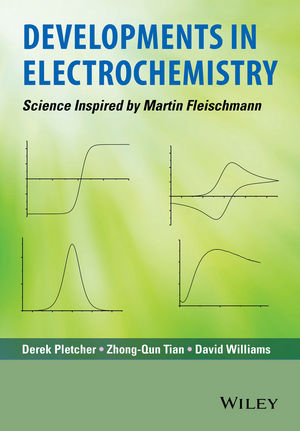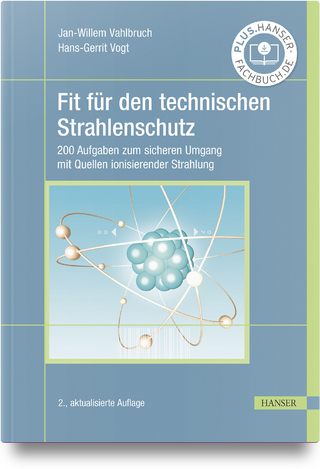
Developments in Electrochemistry
John Wiley & Sons Inc (Verlag)
978-1-118-69443-5 (ISBN)
- Titel z.Zt. nicht lieferbar
- Versandkostenfrei
- Auch auf Rechnung
- Artikel merken
Martin Fleischmann was truly one of the ‘fathers’ of modern electrochemistry having made major contributions to diverse topics within electrochemical science and technology. These include the theory and practice of voltammetry and in situ spectroscopic techniques, instrumentation, electrochemical phase formation, corrosion, electrochemical engineering, electrosynthesis and cold fusion.
While intended to honour the memory of Martin Fleischmann, Developments in Electrochemistry is neither a biography nor a history of his contributions. Rather, the book is a series of critical reviews of topics in electrochemical science associated with Martin Fleischmann but remaining important today. The authors are all scientists with outstanding international reputations who have made their own contribution to their topic; most have also worked with Martin Fleischmann and benefitted from his guidance.
Each of the 19 chapters within this volume begin with an outline of Martin Fleischmann’s contribution to the topic, followed by examples of research, established applications and prospects for future developments.
The book is of interest to both students and experienced workers in universities and industry who are active in developing electrochemical science.
Derek Pletcher is Emeritus Professor at the University of Southampton. His research interests extend from fundamental electrochemistry, through electrochemical engineering to the industrial applications of electrolysis. He is the author of ~ 340 technical papers and ~ 30 reviews and has supervised the training of more than 90 postgraduate students. In 2010, he was awarded the prestigious Vittorio de Nora Medal by the US Electrochemical Society for his work related to the applications of electrochemistry. He is an elected Fellow of the Electrochemical Society (2005) and was awarded their Henry Linford Medal for Teaching Excellence in Electrochemistry (2006). He is a past Editor of the Journal of Applied Electrochemistry (1980 - 85) and presently serves on the Editorial Boards of Electrochimica Acta and Electrochemical Communications. Zhong-Qun Tian heads the Surface-enhanced Raman Spectroscopy and Nano-electrochemistry research group at Xiamen University. He graduated from the Department of Chemistry at Xiamen University in 1982 with a BSc and received his Ph.D in 1987 under advisor, Martin Fleischmann, FRS. He is a Fellow of International Society of Electrochemistry (ISE), 2010- ;Regional Representative (China) of International Society of Electrochemistry (ISE), 2007-2009; Fellow of Royal Society of Chemistry, UK, 2005- ; Council Member of Chinese Society of Micro/Nano Technology, 2005-; Guest Professor of Chemistry, Chinese University of Hong Kong, China, 2006-; Guest Professor of Chemistry, Univ. of Science and Technology of China, China, 2001-; Visiting Professor of Ecole Normal Superior, Paris, France, 2008/9. He has over 310 papers, five chapters in encyclopaedias and books and has edited two special journal issues. David Williams is Professor of Electrochemistry at the University of Auckland, NZ. His research covers electrochemistry and corrosion science. He is a graduate of the University of Auckland and developed his research career in electrochemistry and chemical sensors at the UK Atomic Energy Research Establishment, in the 1980s. He became Thomas Graham Professor of Chemistry at UCL in 1991. He joined the faculty of the Chemistry Dept at Auckland University in 2006. He is an Adjunct Professor at Dublin City University. He is a Visiting Professor at UCL, and University of Southampton, and Honorary Professor of the Royal Institution of Great Britain. He has published around 200 papers in international journals, and is the inventor of around 40 patents.
List of Contributors xiii
1 Martin Fleischmann – The Scientist and the Person 1
2 A Critical Review of the Methods Available for Quantitative Evaluation of Electrode Kinetics at Stationary Macrodisk Electrodes 21
Alan M. Bond, Elena A. Mashkina and Alexandr N. Simonov
2.1 DC Cyclic Voltammetry 23
2.1.1 Principles 23
2.1.2 Processing DC Cyclic Voltammetric Data 26
2.1.3 Semiintegration 29
2.2 AC Voltammetry 32
2.2.1 Advanced Methods of Theory–Experiment Comparison 35
2.3 Experimental Studies 36
2.3.1 Reduction of [Ru(NH3)6]3+ in an Aqueous Medium 36
2.3.2 Oxidation of FeII(C5H5)2 in an Aprotic Solvent 40
2.3.3 Reduction of [Fe(CN)6]3− in an Aqueous Electrolyte 42
2.4 Conclusions and Outlook 43
References 45
3 Electrocrystallization: Modeling and Its Application 49
Morteza Y. Abyaneh
3.1 Modeling Electrocrystallization Processes 53
3.2 Applications of Models 56
3.2.1 The Deposition of Lead Dioxide 58
3.2.2 The Electrocrystallization of Cobalt 60
3.3 Summary and Conclusions 61
References 63
4 Nucleation and Growth of New Phases on Electrode Surfaces 65
Benjamin R. Scharifker and Jorge Mostany
4.1 An Overview of Martin Fleischmann’s Contributions to Electrochemical Nucleation Studies 66
4.2 Electrochemical Nucleation with Diffusion-Controlled Growth 67
4.3 Mathematical Modeling of Nucleation and Growth Processes 68
4.4 The Nature of Active Sites 69
4.5 Induction Times and the Onset of Electrochemical Phase Formation Processes 71
4.6 Conclusion 72
References 72
5 Organic Electrosynthesis 77
Derek Pletcher
5.1 Indirect Electrolysis 79
5.2 Intermediates for Families of Reactions 80
5.3 Selective Fluorination 84
5.4 Two-Phase Electrolysis 85
5.5 Electrode Materials 87
5.6 Towards Pharmaceutical Products 88
5.7 Future Prospects 90
References 91
6 Electrochemical Engineering and Cell Design 95
Frank C. Walsh and Derek Pletcher
6.1 Principles of Electrochemical Reactor Design 96
6.1.1 Cell Potential 96
6.1.2 The Rate of Chemical Change 97
6.2 Decisions During the Process of Cell Design 98
6.2.1 Strategic Decisions 98
6.2.2 Divided and Undivided Cells 98
6.2.3 Monopolar and Bipolar Electrical Connections to Electrodes 99
6.2.4 Scaling the Cell Current 100
6.2.5 Porous 3D Electrode Structures 100
6.2.6 Interelectrode Gap 101
6.3 The Influence of Electrochemical Engineering on the Chlor-Alkali Industry 102
6.4 Parallel Plate Cells 105
6.5 Redox Flow Batteries 106
6.6 Rotating Cylinder Electrode Cells 107
6.7 Conclusions 108
References 109
7 Electrochemical Surface-Enhanced Raman Spectroscopy (EC-SERS): Early History, Principles, Methods, and Experiments 113
Zhong-Qun Tian and Xue-Min Zhang
7.1 Early History of Electrochemical Surface-Enhanced Raman Spectroscopy 116
7.2 Principles and Methods of SERS 117
7.2.1 Electromagnetic Enhancement of SERS 118
7.2.2 Key Factors Influencing SERS 119
7.2.3 “Borrowing SERS Activity” Methods 121
7.2.4 Shell-Isolated Nanoparticle-Enhanced Raman Spectroscopy 123
7.3 Features of EC-SERS 124
7.3.1 Electrochemical Double Layer of EC-SERS Systems 124
7.3.2 Electrolyte Solutions and Solvent Dependency 125
7.4 EC-SERS Experiments 125
7.4.1 Measurement Procedures for EC-SERS 125
7.4.2 Experimental Set-Up for EC-SERS 127
7.4.3 Preparation of SERS Substrates 128
Acknowledgments 131
References 131
8 Applications of Electrochemical Surface-Enhanced Raman Spectroscopy (EC-SERS) 137
Marco Musiani, Jun-Yang Liu and Zhong-Qun Tian
8.1 Pyridine Adsorption on Different Metal Surfaces 138
8.2 Interfacial Water on Different Metals 141
8.3 Coadsorption of Thiourea with Inorganic Anions 143
8.4 Electroplating Additives 146
8.5 Inhibition of Copper Corrosion 147
8.6 Extension of SERS to the Corrosion of Fe and Its Alloys: Passivity 149
8.6.1 Fe-on-Ag 150
8.6.2 Ag-on-Fe 150
8.7 SERS of Corrosion Inhibitors on Bare Transition Metal Electrodes 150
8.8 Lithium Batteries 152
8.9 Intermediates of Electrocatalysis 154
Acknowledgments 156
References 156
9 In-Situ Scanning Probe Microscopies: Imaging and Beyond 163
Bing-Wei Mao
9.1 Principle of In-Situ STM and In-Situ AFM 164
9.1.1 Principle of In-Situ STM 164
9.1.2 Principle of In-Situ AFM 166
9.2 In-Situ STM Characterization of Surface Electrochemical Processes 167
9.2.1 In-Situ STM Study of Electrode–Aqueous Solution Interfaces 167
9.2.2 In-Situ STM Study of Electrode–Ionic Liquid Interface 167
9.3 In-Situ AFM Probing of Electric Double Layer 170
9.4 Electrochemical STM Break-Junction for Surface Nanostructuring and Nanoelectronics and Molecular Electronics 173
9.5 Outlook 176
References 177
10 In-Situ Infrared Spectroelectrochemical Studies of the Hydrogen Evolution Reaction 183
Richard J. Nichols
10.1 The H+/H2 Couple 183
10.2 Single-Crystal Surfaces 184
10.3 Subtractively Normalized Interfacial Fourier Transform Infrared Spectroscopy 186
10.4 Surface-Enhanced Raman Spectroscopy 189
10.5 Surface-Enhanced IR Absorption Spectroscopy 190
10.6 In-Situ Sum Frequency Generation Spectroscopy 193
10.7 Spectroscopy at Single-Crystal Surfaces 194
10.8 Overall Conclusions 197
References 198
11 Electrochemical Noise: A Powerful General Tool 201
Claude Gabrielli and David E. Williams
11.1 Instrumentation 202
11.2 Applications 204
11.2.1 Elementary Phenomena 204
11.2.2 Bioelectrochemistry 205
11.2.3 Electrocrystallization 207
11.2.4 Corrosion 209
11.2.5 Other Systems 215
11.3 Conclusions 217
References 217
12 From Microelectrodes to Scanning Electrochemical Microscopy 223
Salvatore Daniele and Guy Denuault
12.1 The Contribution of Microelectrodes to Electroanalytical Chemistry 224
12.1.1 Advantages of Microelectrodes in Electroanalysis 224
12.1.2 Microelectrodes and Electrode Materials 226
12.1.3 New Applications of Microelectrodes in Electroanalysis 227
12.2 Scanning Electrochemical Microscopy (SECM) 230
12.2.1 A Brief History of SECM 230
12.2.2 SECM with Other Techniques 231
12.2.3 Tip Geometries and the Need for Numerical Modeling 233
12.2.4 Applications of SECM 234
12.3 Conclusions 235
References 235
13 Cold Fusion After A Quarter-Century: The Pd/D System 245
Melvin H. Miles and Michael C.H. McKubre
13.1 The Reproducibility Issue 247
13.2 Palladium–Deuterium Loading 247
13.3 Electrochemical Calorimetry 249
13.4 Isoperibolic Calorimetric Equations and Modeling 250
13.5 Calorimetric Approximations 251
13.6 Numerical Integration of Calorimetric Data 252
13.7 Examples of Fleischmann’s Calorimetric Applications 254
13.8 Reported Reaction Products for the Pd/D System 256
13.8.1 Helium-4 256
13.8.2 Tritium 256
13.8.3 Neutrons, X-Rays, and Transmutations 257
13.9 Present Status of Cold Fusion 257
Acknowledgments 258
References 258
14 In-Situ X-Ray Diffraction of Electrode Surface Structure 261
Andrea E. Russell, Stephen W.T. Price and Stephen J. Thompson
14.1 Early Work 262
14.2 Synchrotron-Based In-Situ XRD 264
14.3 Studies Inspired by Martin Fleischmann’s Work 266
14.3.1 Structure of Water at the Interface 266
14.3.2 Adsorption of Ions 268
14.3.3 Oxide/Hydroxide Formation 268
14.3.4 Underpotential Deposition (upd) of Monolayers 270
14.3.5 Reconstructions of Single-Crystal Surfaces 275
14.3.6 High-Surface-Area Electrode Structures 275
14.4 Conclusions 277
References 277
15 Tribocorrosion 281
Robert J.K. Wood
15.1 Introduction and Definitions 281
15.1.1 Tribocorrosion 282
15.1.2 Erosion 282
15.2 Particle–Surface Interactions 283
15.3 Depassivation and Repassivation Kinetics 283
15.3.1 Depassivation 284
15.3.2 Repassivation Rate 286
15.4 Models and Mapping 287
15.5 Electrochemical Monitoring of Erosion–Corrosion 290
15.6 Tribocorrosion within the Body: Metal-on-Metal Hip Joints 291
15.7 Conclusions 293
Acknowledgments 293
References 293
16 Hard Science at Soft Interfaces 295
Hubert H. Girault
16.1 Charge Transfer Reactions at Soft Interfaces 295
16.1.1 Ion Transfer Reactions 296
16.1.2 Assisted Ion Transfer Reactions 298
16.1.3 Electron Transfer Reactions 299
16.2 Electrocatalysis at Soft Interfaces 300
16.2.1 Oxygen Reduction Reaction (ORR) 301
16.2.2 Hydrogen Evolution Reaction (HER) 302
16.3 Micro- and Nano-Soft Interfaces 304
16.4 Plasmonics at Soft Interfaces 305
16.5 Conclusions and Future Developments 305
References 307
17 Electrochemistry in Unusual Fluids 309
Philip N. Bartlett
17.1 Electrochemistry in Plasmas 310
17.2 Electrochemistry in Supercritical Fluids 314
17.2.1 Applications of SCF Electrochemistry 321
17.3 Conclusions 325
Acknowledgments 325
References 325
18 Aspects of Light-Driven Water Splitting 331
Laurence Peter
18.1 A Very Brief History of Semiconductor Electrochemistry 332
18.2 Thermodynamic and Kinetic Criteria for Light-Driven Water Splitting 334
18.3 Kinetics of Minority Carrier Reactions at Semiconductor Electrodes 336
18.4 The Importance of Electron–Hole Recombination 338
18.5 Fermi Level Splitting in the Semiconductor–Electrolyte Junction 339
18.6 A Simple Model for Light-Driven Water-Splitting Reaction 341
18.7 Evidence for Slow Electron Transfer During Light-Driven Water Splitting 343
18.8 Conclusions 345
Acknowledgments 345
References 346
19 Electrochemical Impedance Spectroscopy 349
Samin Sharifi-Asl and Digby D. Macdonald
19.1 Theory 350
19.2 The Point Defect Model 350
19.2.1 Calculation of Y0F 355
19.2.2 Calculation of ΔC0 i ΔU 355
19.2.3 Calculation of ΔCL v ΔU 356
19.3 The Passivation of Copper in Sulfide-Containing Brine 357
19.4 Summary and Conclusions 363
Acknowledgments 363
References 363
Index 367
| Verlagsort | New York |
|---|---|
| Sprache | englisch |
| Maße | 177 x 252 mm |
| Gewicht | 907 g |
| Themenwelt | Naturwissenschaften ► Chemie ► Physikalische Chemie |
| Technik ► Maschinenbau | |
| ISBN-10 | 1-118-69443-0 / 1118694430 |
| ISBN-13 | 978-1-118-69443-5 / 9781118694435 |
| Zustand | Neuware |
| Informationen gemäß Produktsicherheitsverordnung (GPSR) | |
| Haben Sie eine Frage zum Produkt? |
aus dem Bereich


